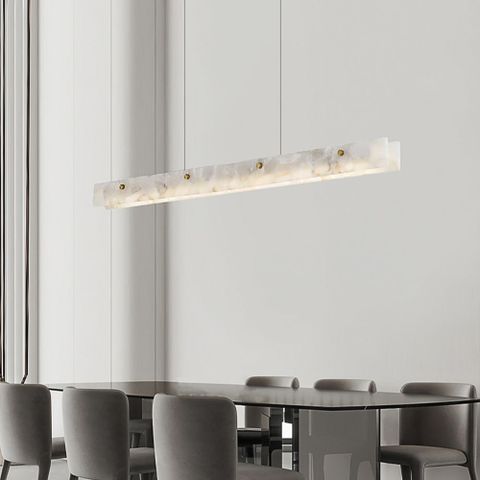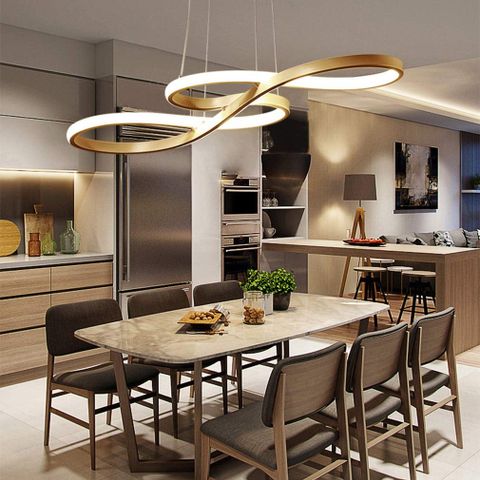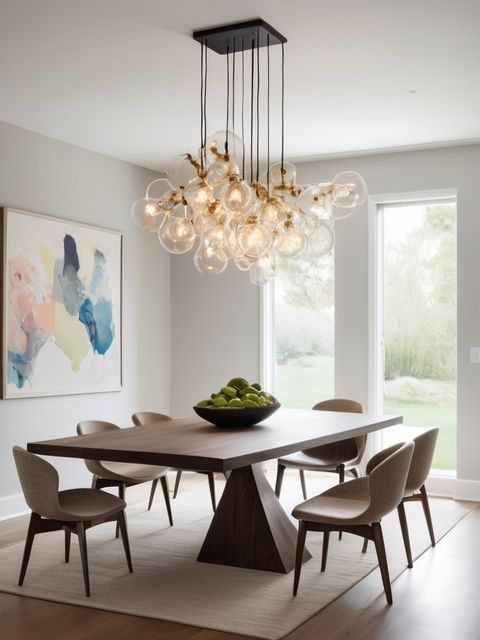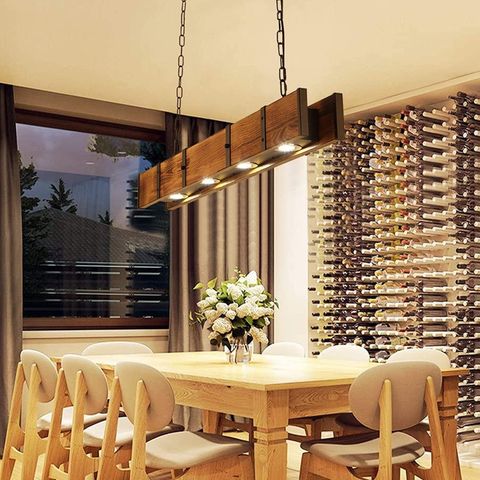Picture this: you walk into your dining room and the lights adjust automatically to create the perfect ambiance for dinner. The mood lighting shifts subtly as you start your meal, and your guests notice something different about the space. This isn’t science fiction – it’s happening right now in modern homes across the country.
The dining room has always been the heart of the home, but today’s contemporary spaces are taking this central role even further. What was once just about having enough light to see your food has evolved into creating experiences that engage all the senses. Smart lighting systems have become essential elements in modern dining room design, offering homeowners unprecedented control over atmosphere, functionality, and energy efficiency. These systems don’t just turn lights on and off – they transform how we think about space, mood, and social interaction.
The Evolution of Dining Room Lighting
Traditional dining rooms relied heavily on chandeliers or overhead fixtures that provided basic illumination. Today’s approach is far more nuanced and purposeful. The shift began when designers realized that lighting could dramatically influence the entire dining experience. Gone are the days when a single fixture had to serve every function. Instead, we now see layered lighting solutions that can adapt to different times of day, seasons, and occasions.
Consider how a warm, golden glow during evening meals creates intimacy compared to bright, white light during afternoon gatherings. Modern smart systems allow for these transitions seamlessly. They respond to time, occupancy, and even weather conditions. A system might dim automatically when sunset approaches or brighten when someone enters the room. This level of responsiveness wasn’t possible before smart technology entered the equation.
Key Smart Features in Modern Dining Rooms
Smart lighting systems offer several core capabilities that have revolutionized dining room design:
• Color Temperature Control: This feature allows users to switch between cool daylight tones and warm ambient lighting. During breakfast, you might prefer crisp white light for clarity, while dinner calls for softer amber tones that encourage conversation.
• Dimming Capabilities: Unlike traditional dimmers that offer limited adjustment, smart systems provide infinite dimming ranges. You can set precise levels that match your exact needs.
• Scheduling and Automation: Many systems integrate with home automation platforms, allowing you to program lighting behavior based on daily routines. Lights can come on 30 minutes before dinner time or adjust gradually as the sun sets.
• Voice Control Integration: Compatibility with voice assistants like Alexa or Google Home means you can adjust lighting without getting up from your seat. Imagine telling your system to ‘make the dining room cozy’ before guests arrive.
• Mobile App Control: Smartphone apps give you remote access to lighting controls, enabling you to adjust settings from anywhere in the house. You can check if lights are on before leaving for work or prepare the perfect atmosphere for a special occasion.
Integration with Home Automation Systems
Contemporary dining room design increasingly relies on interconnected systems rather than isolated components. Smart lighting integrates naturally with other home automation features. When your smart lighting system connects to your thermostat, it might automatically adjust based on room temperature changes. If it links to your security system, lights can simulate occupancy when you’re away.
The marriage of lighting with other smart home technologies creates cascading effects. For instance, when you activate your dining room lighting through a voice command, it might also trigger the coffee maker to start brewing or adjust the blinds to let in natural light. These connections make homes feel more alive and responsive to their inhabitants’ needs.
Some advanced systems even learn from your habits over time. They might notice that you typically eat dinner around 7 PM and automatically begin preparing the dining area’s lighting about 30 minutes beforehand. It’s like having a personal assistant who understands your preferences without being asked.
Energy Efficiency and Sustainability Benefits
Beyond aesthetics, smart lighting brings substantial environmental advantages. Traditional incandescent bulbs waste significant energy as heat rather than light. LED bulbs already offer dramatic improvements, but smart systems enhance these benefits considerably.
Smart systems can detect when spaces are unoccupied and automatically dim or turn off lights. Some even track usage patterns to optimize energy consumption. For example, a system might recognize that certain areas of your home aren’t used during specific hours and adjust accordingly.
The ability to fine-tune lighting intensity also reduces overall power consumption. Rather than running full-brightness lights throughout a room, you can provide exactly the amount of illumination needed. This precision leads to measurable savings on electricity bills. In a typical household, smart lighting can reduce energy consumption by 20-40% compared to conventional systems.
Many modern systems also support renewable energy integration. When paired with solar panels, smart lighting can maximize usage of clean energy during peak production hours, effectively storing energy for later use.
Design Flexibility and Customization Options
One of the most exciting aspects of smart lighting in dining rooms is the flexibility it offers in design execution. Traditional lighting often required permanent installations that were difficult to modify. Smart systems allow for much more experimentation and adaptation.
You can easily change the look and feel of a dining space without major renovations. A simple app update can alter color schemes, lighting patterns, or entire scenes. This adaptability makes it easy to match seasonal decor changes or accommodate different types of gatherings. A casual family dinner might call for soft, warm lighting, while a formal dinner party might require more dramatic accent lighting.
Customization extends beyond visual appeal. Some systems allow you to create specific lighting profiles for different activities. Cooking might benefit from bright, even illumination, while entertaining might require more atmospheric lighting. The ability to store and recall these settings means you can quickly switch between different moods and functions.
Smart lighting also accommodates accessibility needs. People with vision impairments or mobility issues can benefit from automated lighting adjustments that ensure safe navigation through the space. Adjustable brightness levels can also help individuals with photosensitivity or other medical considerations.
Practical Implementation and Cost Considerations
Implementing smart lighting in a dining room involves several practical decisions. Starting with existing infrastructure is crucial. Most smart lighting systems work with standard electrical outlets and fixtures, but some may require professional installation for optimal results. The initial investment varies significantly based on the complexity of the system and the size of the space.
Basic smart lighting kits can cost anywhere from $100 to $500, while comprehensive systems with multiple sensors and automation features might reach $1,500-$3,000. However, many experts note that these costs are offset within the first year through energy savings alone. The convenience factor also adds significant value that’s hard to quantify.
When planning implementation, consider your lifestyle and priorities. If you frequently host dinners, investing in a sophisticated system with multiple zones and automation might pay dividends. For simpler needs, basic smart bulbs or switches might suffice. The key is matching functionality to actual usage patterns rather than buying the most expensive options available.
Professional installation services are available for those who want seamless integration. These services typically include proper placement of sensors, programming of automation rules, and setup of mobile applications. While adding to the initial cost, professional installation ensures optimal performance and reduces frustration during the learning curve.
The integration of smart lighting features in contemporary dining room design represents more than just technological advancement – it’s a fundamental shift in how we approach domestic spaces. These systems transform simple lighting into a dynamic element that enhances our daily lives in subtle but meaningful ways. From the way we entertain to how we relax, smart lighting creates environments that respond to our needs rather than forcing us to adapt to static conditions.
As technology continues evolving, we can expect even more sophisticated integration between lighting and other home systems. The dining room of tomorrow will likely offer even greater personalization, deeper automation, and more intuitive control mechanisms. For homeowners today, embracing smart lighting means stepping into a future where their living spaces become truly responsive companions rather than passive backdrops.
Whether you’re renovating a space or simply looking to upgrade your current setup, smart lighting offers tangible benefits that extend far beyond simple illumination. It’s about creating spaces that not only look beautiful but also function intelligently, efficiently, and intuitively. The investment in smart lighting is ultimately an investment in quality of life, comfort, and the kind of thoughtful design that makes everyday moments feel special.














